Recently, the research of molecular biology and the neuroscience field has developed rapidly.
However, perception and recognition to learning and memory, sensory input and information processing to movement instruction, brain's function as system to action representation, remain to be elucidated.
The insect brain (microbrain) realizes reflection, fixed pattern behavior to more advanced function of sensory reception and behavior control, like learning and memory, inspite of small number of neurons.
So, the insect brain is a suitable model system as analyzing nerve system's sensory input to behavior, mechanism of adaptation.
This research group aims to clarify microbrain's adaptation ability by analysis of insect's brain at molecular level, single neuron level, neural network level, and behavior level, and integrating those results to the robot.
Moreover, this group collaborates with bio-machine hybrid system group, and we aim to realize the function of adaptation.
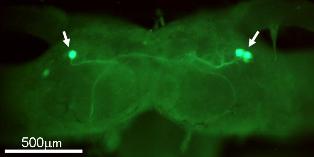
Unraveling structure and function of neuronal circuits with transgenic moths
Transgenic techniques are powerful tools that allow us to visualize and
monitor the activities of a specific subset of neurons, and to inhibit
or shut down neuronal function in intact animals. For the understanding
of function of specific neuronal circuits, we are currently generating
transgenic silkmoths expressing exogenous genes in various subsets of neuron
populations using various gene promoters. Figure shows a fluorescent image
of a brain expressing GFP under the control of prothoracicotropic hormone
(PTTH) promoter. In this moth, PTTH neurosecretory cells (arrows) are exclusively
visualized with GFP fluorescence.
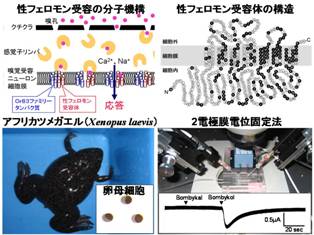
In insects females emit `sex pheromonef composed of some volatile compounds to attract conspesific male. Although these compounds were identified from various insect species, the reception mechanism by male was unknown. We discovered the sensor protein, called `sex pheromone receptorf, from male moth antennae, and demonstrated that this receptor specifically responds to a sex pheromone component emitted by female moth. To date we identified sex pheromone receptor genes from six moth species. However, it remain unknown how these receptor proteins discriminate between the chemical structures of sex pheromone components and how male moths sniff out conspecific female moths. I try to demonstrate how male recognize conspecific female focusing on these sex pheromone receptors. Elucidation of pheromone recognition mechanism in insect leads to the development of the noble pest control agents as an alternative to harmful pesticides and the biosensor with ligand specific olfactory receptors.
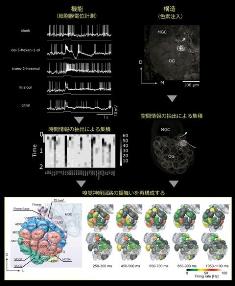
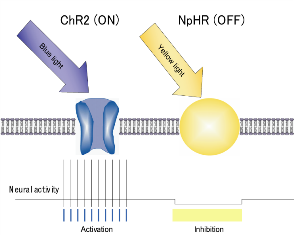
Optogenetic Identification of Functional Neural Circuitry
Recently identified two light-activated proteins (ChR2, NpHR) are widely accepted as complementary tools to give parametric perturbation to genetically defined neurons. These molecular tools enable to control neural activity at time scales of milliseconds. We successfully generated a transgenic silkmoth expressing these optogenetic tools. Controlling targeted neurons with high temporal resolution may shed light on the causal neural codes underlying computational circuit and accompanied behavior.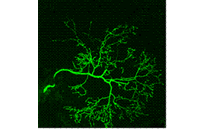

BOmbyx Neuron Database (BOND)
Invertebrate Brain Platform
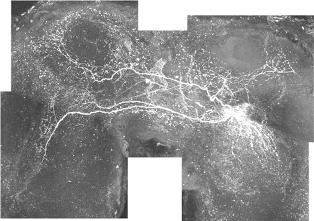
Ca(2+) imaging is a useful method to visualize the multi neuronal activities. Measuring the changes of fluorescence intensity in the labeled neuons when odors are given, we are analyzing how brains encode odor inputs using neuronal assemblies.
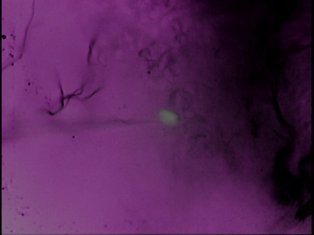
My major research interests are neural plasticity and the control of behaviour. My past work comprises map reconstruction and plasticitiy inrodent SI cortex (extracellular recordings in vivo), optical imaging with voltage sensitive for a comparative analysis of cortical areas (in rat and mouse brain slices), and an analysis of the gustatory system of the honeybee with special reference to its importance in relaying the unconditioned stimulus in learning experiments (electrophysiology, behaviour, and neuroanatomical tracing). I have also briefly worked with the pharyngeal system of C. elegans. Currently, I am chiefly concerned with pheromone information processing and orientation in the male silkmoth. This topic spans various levels (from intact animal EAGs at the input to motoneurons and muscular effectors at the output) and necessits a wide range of techniques including neuroanatomical tracing, electrophysiology, microstimulation of specific brain areas, and pharmacological manipulations in order to understand how the brain of the silkmoth generates motor control signal sequences resulting in zig-zag walking and looping behaviour, the components that allow the male silkmoth to localise a pheromone-releasing mate with 100% certainty. This robust goal-finding behaviour in the presence of intermittent input and a shallow concentration gradient is futher employed as a model system to implement these desirable properties in autonomous systems. Other projects pursued for some time already include orientation in fiddler crabs to understand path integration and comparative neuroanatomy of arthopods.